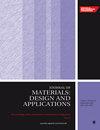碱硅烷表面接枝菠萝纤维对不同水温和温度条件下老化环氧树脂复合材料层析和钻孔损伤行为的影响
IF 2.2
4区 材料科学
Q3 MATERIALS SCIENCE, MULTIDISCIPLINARY
Proceedings of the Institution of Mechanical Engineers, Part L: Journal of Materials: Design and Applications
Pub Date : 2024-08-22
DOI:10.1177/14644207241277511
引用次数: 0
摘要
轻质复合材料的出现带动了复合材料领域的众多研究创新。为了了解材料在不同环境条件下的工作性能,本研究考察了在不同老化条件下经过化学处理的天然纤维复合材料的机械和加工性能。本研究使用环氧树脂和三乙烯四胺固化剂以及经过化学处理的菠萝纤维来制作复合材料。复合材料板采用手工铺层法制作,并在 40 °C 和 60 °C 的不同老化条件下进行 30 天的后固化,以及在海水和雨水中浸泡相同的时间。尽管经历了不同的老化条件,B 系列试样的机械性能仍优于未经处理的试样。B 系列试样(B0、B1、B2、B3 和 B4)的轨向剪切力和搭接剪切力值分别约为 19 兆帕至 27 兆帕和 15 兆帕至 23 兆帕。此外,B 系列试样的疲劳寿命更长,约为 16,000 至 20,000 周期,最大应力值约为 56 MPa 至 70 MPa。钻孔宏观扫描显示,与未经处理的试样相比,经过化学处理的试样具有最小的纤维拉出、尺寸稳定性和更好的粘结性。总之,这项研究表明,经过化学处理的纤维复合材料具有优异的机械性能和加工特性,是汽车、工业、土木工程、海洋工程和航空领域等各种工业应用的理想材料。本文章由计算机程序翻译,如有差异,请以英文原文为准。
Effects of alkali-silane surface-grafted pineapple fibre on lamina delamination & drilling damage behaviour of aged epoxy composites under various water and temperature
The emergence of light-weight compounds has led to numerous research innovations in the field of composite materials. In order to find out how well materials work when they are exposed to different environmental conditions, this study looks at the mechanical and machining properties of natural fiber composite materials that have been chemically treated under different aging conditions. Epoxy resin and triethylenetetramine hardener were utilized to make composites, along with chemically treated pineapple fiber. Composite plates were fabricated using a manual layup method and post-cured under different aging conditions of 40 °C and 60 °C for 30 days, as well as immersion in sea water and rain water for the same duration. Despite undergoing aging conditions, the B-series specimens exhibited superior mechanical properties compared to untreated ones. The B-series specimens (B0, B1, B2, B3, and B4) showed rail shear and lap shear values ranging from approximately 19 MPa to 27 MPa and 15 MPa to 23 MPa, respectively. Additionally, the B-series specimens demonstrated higher fatigue life counts ranging from approximately 16,000 to 20,000 cycles, along with maximum stress values ranging from approximately 56 MPa to 70 MPa. Drilling macroscopic scans revealed that chemically treated specimens exhibited minimal fiber pull-out, dimensional stability, and improved bonding compared to untreated specimens. Overall, the study demonstrates that chemically treated fiber composites exhibit superior mechanical properties and machining characteristics, making them promising materials for various industrial applications, including automobiles, industrial, civil, and marine engineering, and the aviation sector.
求助全文
通过发布文献求助,成功后即可免费获取论文全文。
去求助
来源期刊

CiteScore
4.70
自引率
8.30%
发文量
166
审稿时长
3 months
期刊介绍:
The Journal of Materials: Design and Applications covers the usage and design of materials for application in an engineering context. The materials covered include metals, ceramics, and composites, as well as engineering polymers.
"The Journal of Materials Design and Applications is dedicated to publishing papers of the highest quality, in a timely fashion, covering a variety of important areas in materials technology. The Journal''s publishers have a wealth of publishing expertise and ensure that authors are given exemplary service. Every attention is given to publishing the papers as quickly as possible. The Journal has an excellent international reputation, with a corresponding international Editorial Board from a large number of different materials areas and disciplines advising the Editor." Professor Bill Banks - University of Strathclyde, UK
This journal is a member of the Committee on Publication Ethics (COPE).
 求助内容:
求助内容: 应助结果提醒方式:
应助结果提醒方式:


